Exhaust air or circulating air is the question
Promising kitchen ventilation systems!
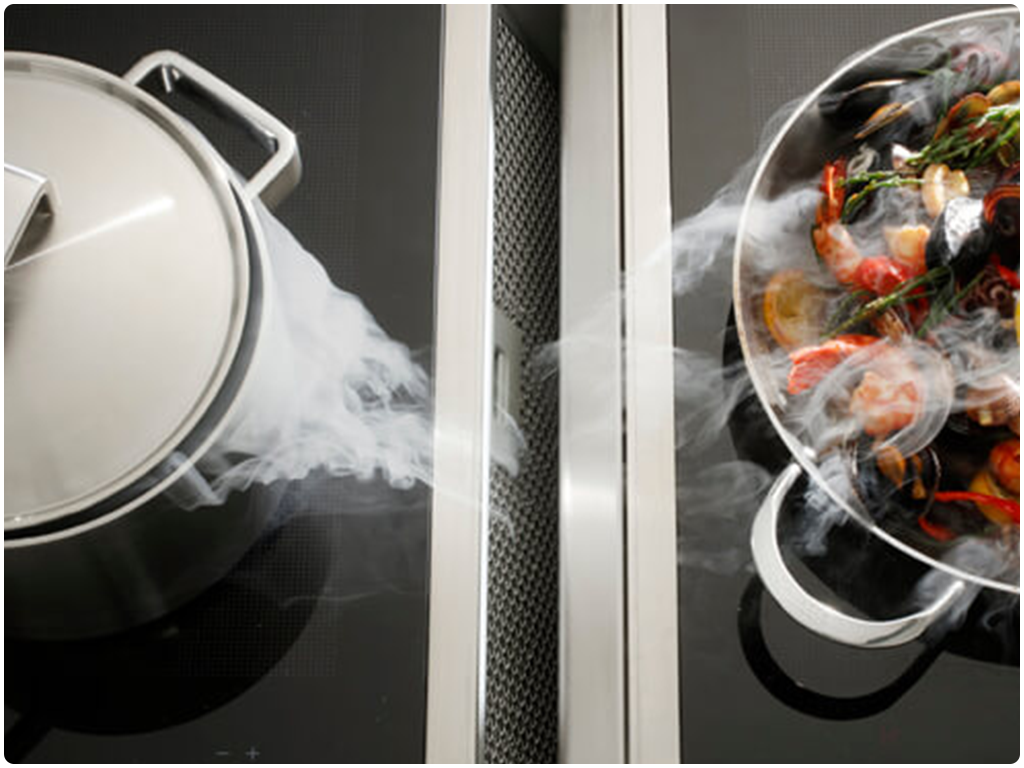
Cooking’s fun and creative. It sizzles, steams and smells delicious. In the long run, though, cooking fumes are a bother. Without an extractor, it’s only half the fun. But it depends on the details. In most cases, exhaust air is better than recirculating air, saving money in the end.
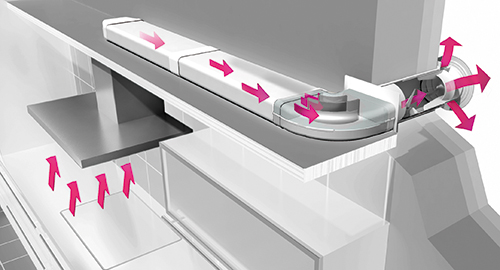
Perfectly planned exhaust air system with Naber COMPAIR® flow products.
No matter which type of extractor fan you prefer, right at the beginning you need to decide between exhaust or recirculated air. With exhaust air, the extracted cooking vapour is conveyed from the extractor hood via a pipe and a wall conduct to the outdoors. A recirculating system partially filters out grease and odours from the vapour and blows the air back into the room. Moisture is not extracted by this variant at all.
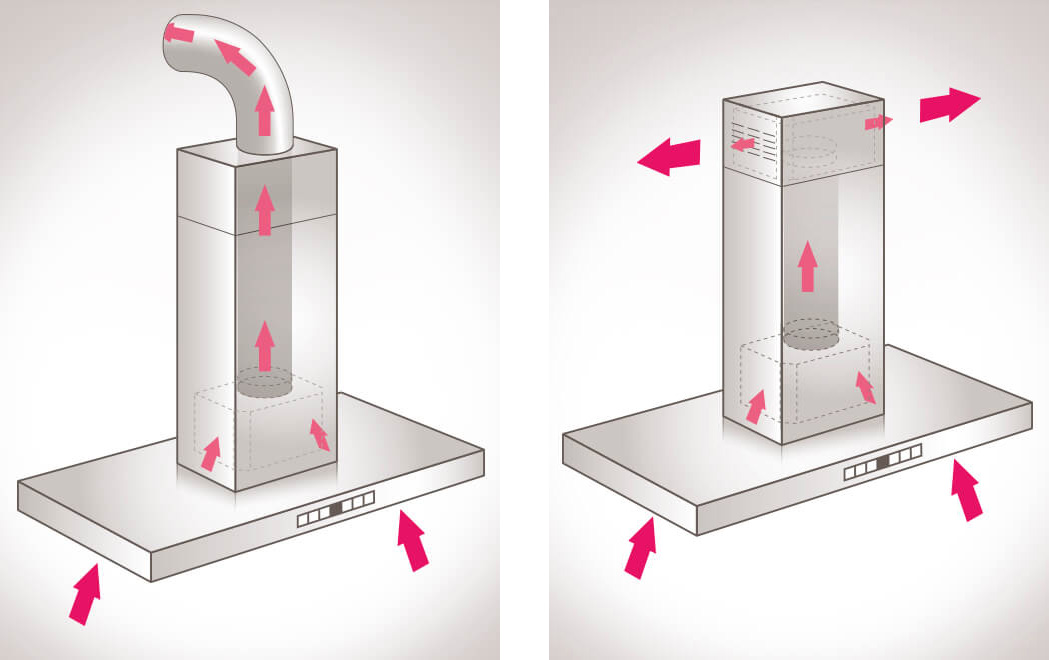
Extractor hood in exhaust air (left) and in recirculation mode (right)
Pros and cons
In practice, this decision has far-reaching consequences. Therefore, here you will find all the arguments for and against one of the two variants. A tip: implementation problems with extractors can be avoided if the parties discuss the matter in good time. Naber offers the perfect air routing for both variants. We are convinced that exhaust air is the better solution, also for low-energy, efficiency and passive houses.
Good arguments
Our decades of experience as one of the leading specialists in kitchen ventilation technology, and the intensive cooperation with all manufacturers of extractor hoods around the world confirm this day in day out. The consumer organisation Stiftung Warentest also rates exhaust air clearly better than recirculating air. All in all, an extractor hood with an exhaust air solution is the more efficient, cheaper and more convenient option. Of course, there are good reasons for recirculating air. Find out and decide for yourself.
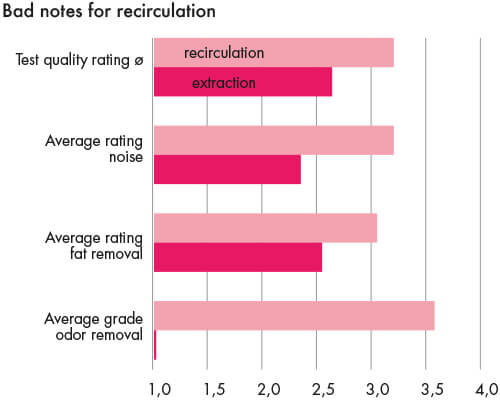
Recirculating air solutions perform worse than exhaust air in all important aspects.
| Advantages of exhaust air: | Advantages of circulating air: |
|---|---|
| Significantly better performance with the same device | Slightly less planning effort |
| Grease and odours are efficiency removed | Easier to install retrospectively |
| Moisture disappears from the home | Available for every installation variant |
| Mould on walls and in furniture is not an issue | No additional effort for single room furnaces |
| Higher energy efficiency | Slightly lower heating costs in highly insulated buildings |
| Significantly quieter with the same performance | |
| Cheaper in the long term, no filter costs | |
| Available for every installation variant | |
| Can be combined with room-air-independent single room furnaces |
| Disadvantages of exhaust air: | Disadvantages of circulating air: |
|---|---|
| Timely planning necessary | Up to 40 percent powerloss |
| Wall or roof penetration required | Grease and odours are removed less effectively |
| Somewhat higher purchase and installation costs | Moisture stays entirely in the home |
| Planning requirement for duct systems in multi- family dwellings | Significantly louder |
| Supply air via window or supply air duct | Danger of mould - also in kitchen furniture |
| Window switch for room-air-dependent heat- producing appliances | Additional window ventilation necessary |
| Filter exchange costs up to 300 Euros per year | |
| Higher electricity costs | |
| Additional cleaning of a ventilation system |
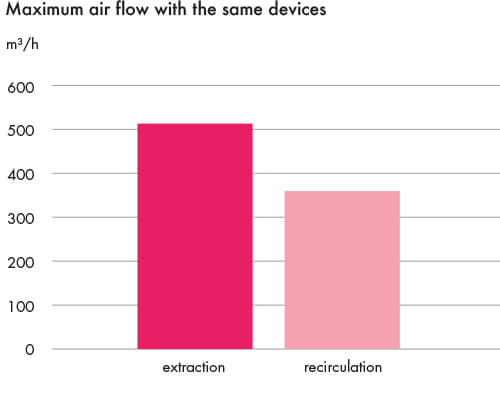
Exhaust air solutions are more powerful than recirculating air solutions.
Exhaust air saves money
The technical, health and convenience advantages of exhaust air routing in extractor systems of any type are known: if the cooking fumes (vapours) are guided out of the house, the extractor works more effectively. The maximum air capacity is up to 40 percent higher because the air does not have to be forced through additional filters. In addition, the devices are quieter. The decisive aspect: the cleaning performance is significantly better. Odours, grease and other particles are removed much better, and water vapour is extracted, which is not the case at all with recirculating air systems. This was clearly established by the examiners of Stiftung Warentest in a detailed test of 17 extractor hoods of different types in all price classes (source: magazine "test", 3/2016).
Over the service life of an extractor hood almost 1,500 Euros price advantage!
The price advantage of an exhaust air system over recirculated air based on the assumed 20 years’ service life of the devices can also be established from the product testers’ figures. For this, we calculated the average value from the above test and compared it to the list prices of Naber air duct sets and wall conducts. We assume that the wall penetration has already been carried out and that the recirculating air devices are already equipped with a first set of the required filters.
Here are our results (all figures in Euro):
| Items | Exhaust air | Recirculating air |
| COMPAIR® 150 flow air duct set 1 (2 meters long) | 121.85 | - |
| E-Jal Col 150 wall conduct with THERMOBOX and stainless steel blind | 239.50 | - |
| Add. installation work (1 hr.) | 47 | - |
| Average costs recirculating air operation acc. test 3/2016 | - | 81 |
| Average costs of filter exchange (94 €/a) for 19 years | - | 1,786 |
| Total | 408.35 | 1,867 |
| Price advantage exhaust air in 20 years | 1,458.65 |
Source: Stiftung Warentest, magazine „test“, issue 3/2016, Naber list prices 7/2018, own calculations
Almost 1,500 Euros can be saved on average, if you bank on exhaust air. And that with significantly better performance and convenience. The costs stated are deliberately given as average values. The prices for filters in the test range from 13 to 297 Euros. The additional costs for the recirculating air operation are given by "test" as 0 to 259 Euros. Anyone who has to choose between exhaust air and recirculating air should therefore get detailed information about the subsequent costs of their decision.
In the popular downdraft systems which Stiftung Warentest did not examine, the annual filter costs tend to be at the upper end of the scale or even above.
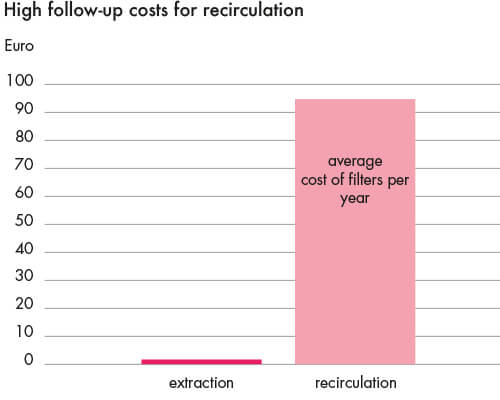
Recirculating air solutions are – with proper maintenance – much more expensive than exhaust air.